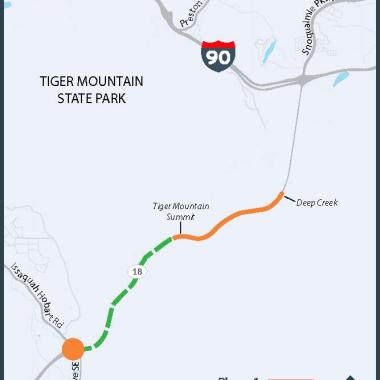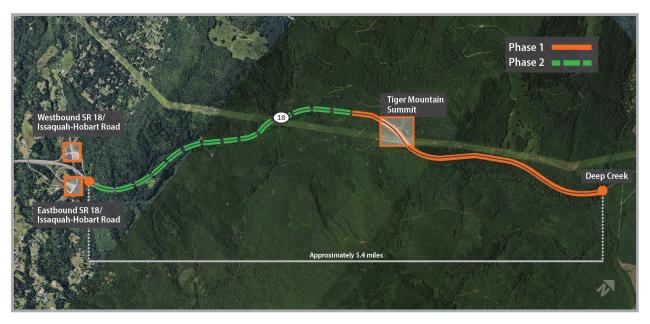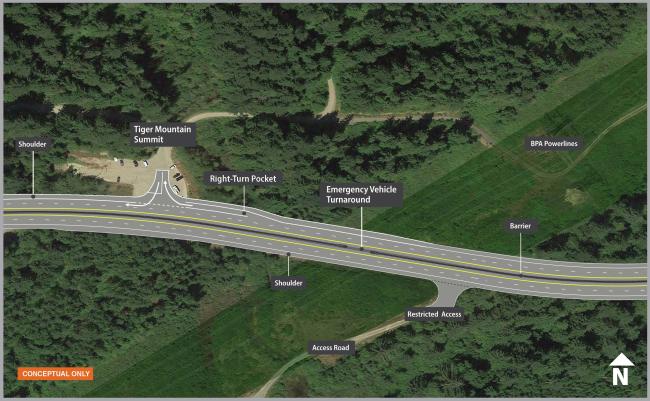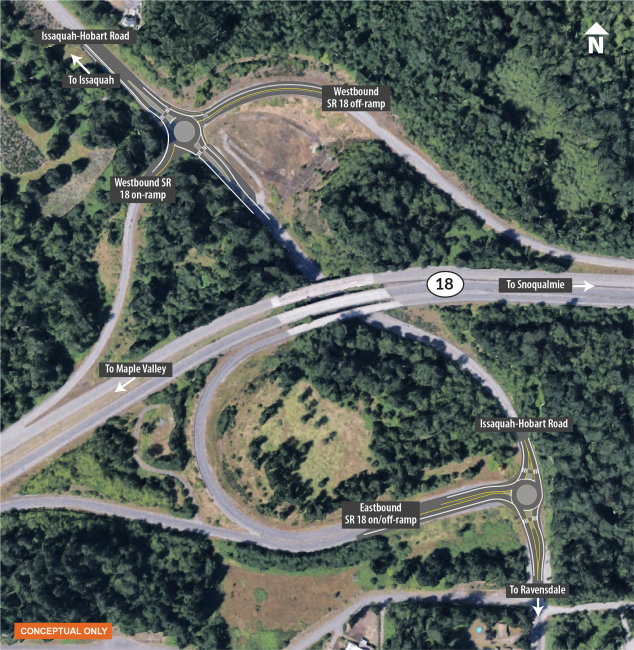Project overview
SR 18 is a crucial highway connecting the south Puget Sound area with I-90, the state's main east-west route. SR 18 has experienced frequent congestion and collisions for decades.
WSDOT received construction funding from the 2022 Move Ahead Washington transportation package and is preparing to widen a 5-mile section of SR 18 between Issaquah-Hobart Road and Deep Creek.
What to expect
We anticipate it will take several construction seasons to complete the work because we expect to keep the highway open during construction. The first phase of the project is being readied for construction, which could begin as early as 2030.
WSDOT is proposing to widen five miles of SR 18 to two lanes in each direction between Issaquah/Hobart Road and Deep Creek.
SR 18 is one lane in each direction through this area, with truck climbing lanes on each uphill side of Tiger Mountain for the 27,000 vehicles that use the highway each day. A serious collision in the single-lane sections can require one or both directions of the highway to close until it is cleared. Although other segments of the highway between Auburn and Maple Valley have been improved, this segment continues to experience congestion and serious collisions.
Move Ahead Washington was approved by state legislators in 2022 to invest $16.9 billion in major transportation projects over the next 16 years. As part of the approval, construction funding is being provided to improve SR 18 between Issaquah-Hobart Road and Deep Creek after a separate project widens the highway from Deep Creek to I-90. The preferred alternative will construct the following in two construction phases:
Phase 1 - East contract
- Two lanes in each direction between Tiger Mountain summit near milepost 23 and Deep Creek near milepost 26.
- A median barrier from the summit to Deep Creek.
- Right-in, right-out access at the Tiger Mountain summit entrance.
- Two roundabouts at the Issaquah-Hobart Road Southeast interchange.
- Ten bridges and more than 40 retaining walls.
- Corrections to five fish passage barriers and multiple wildlife crossings.
- Stormwater improvements.
- Fiber cable installation will add a weather monitoring system at Tiger Mountain summit and ramp meters at the new interchange.
Phase 2 - West contract
- Two lanes in each direction between Issaquah-Hobart Road Southeast near milepost 21 and Tiger Mountain summit near milepost 23.
- A median barrier between Issaquah-Hobart Road Southeast and the summit.
- Nine bridges and approximately 50 retaining walls.
- Corrections to six fish passage barriers and multiple wildlife crossings.
- Stormwater improvements.
- Extend the fiber optic line network from the existing Intelligent Transportation System (ITS), improving resilience and reliability of the network.
- Install ITS data station and camera facilities.
To prepare for construction, we will continue advancing the conceptual design and conducting National Environmental Policy Act reviews for the more than 5-mile corridor, which considers potential affects to natural and social resources in the area. NEPA and the Endangered Species Act consultation began in 2022 and will be complete before construction begins.
Between 2020 and 2021 we engaged regional leaders to support the process and help refine the project design. A Technical Advisory Committee has been meeting since 2020 with representatives from state, tribal and local governments, environmental and resource agencies and non-governmental organizations. The TAC supported the design process by identifying key features of the preferred alternative. An Executive Advisory Group of local, state tribal and non-governmental leaders was also convened later in 2020 and continues to advise WSDOT and share project information with their communities.
Collisions and injuries (2008-2021)
- There were more than 400 collisions on SR 18, involving 740 vehicles.
- There were six fatalities and more than 170 people injured.
A more detailed study of crashes between 2014 and 2019 showed that 48% of crashes took place near the Tiger Mountain summit trailhead. Widening the highway, completing the installation of a center barrier and redesigning access to the Tiger Mountain parking area at the summit will reduce the risk and frequency of collisions.
Addressing traffic congestion
Existing congestion will continue to worsen without corridor improvements. Eastbound traffic generally backs up between the Tiger Mountain summit and the Issaquah-Hobart Road interchange. In the westbound direction, traffic backs up during both the morning and afternoon commutes, with congestion stretching between Deep Creek and I-90.
Traffic modeling using design year 2045 projects traffic with and without corridor improvements indicating the following:
Eastbound mornings between Issaquah-Hobart Road and I-90
- With no corridor improvements: congestion increases more than 100%, increasing travel times from 31 minutes to more than an hour. Backups will extend beyond Issaquah-Hobart Road.
- With corridor improvements: Travel times will decrease more than 70% from 62 minutes to just more than 11 minutes.
Eastbound evenings between Issaquah-Hobart Road and I-90
- With only marginal changes from existing traffic since peak use is not eastbound in the afternoons and evenings.
Westbound mornings between I-90 and Issaquah-Hobart Road
- With no corridor improvements: SR 18 travel times decrease approximately 4% due to widening of SR 18 between I-90 and Deep Creek as part of the I-90/SR 18 interchange improvement project.
- With corridor improvements: Morning travel times will decrease by approximately 10%.
Westbound evenings between I-90 and Issaquah-Hobart Road
- With no corridor improvements: Travel times will increase by more than 90%, from about 12 minutes to 24 minutes. Backups will extend from west of the Tiger Mountain summit to the I-90 interchange.
- With corridor improvements: Travel times are reduced from 24 minutes to about 10 minutes.
I-90/SR 18 interchange improvements and widening
As part of a separately funded project extending from Deep Creek to I-90, WSDOT is also improving the eastern end of the highway to provide additional capacity, improve safety and reduce existing congestion. Information about that project including history, timeline and funding can be found here.




